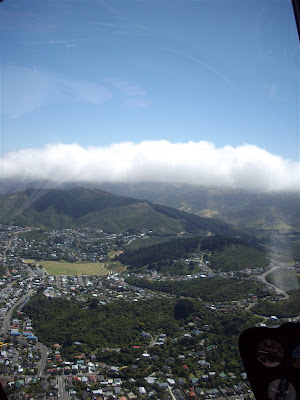 For a city of 125,000 souls (1/5th of them students), Dunedin has a bustling-- and distinctly Scottish-- feel. The very name is Gaelic for Edinburgh, the streets bear Scottish names and the obligatory statue of Robert Burns graces the city centre. The elegant old home at left, called Corstorphine House, is another landmark of this heritage, and perhaps the most gracious lodging we have enjoyed during our travels throughout New Zealand.
For a city of 125,000 souls (1/5th of them students), Dunedin has a bustling-- and distinctly Scottish-- feel. The very name is Gaelic for Edinburgh, the streets bear Scottish names and the obligatory statue of Robert Burns graces the city centre. The elegant old home at left, called Corstorphine House, is another landmark of this heritage, and perhaps the most gracious lodging we have enjoyed during our travels throughout New Zealand.Of the many things we could have done with a few hours in the city, we chose perhaps the most touristy, climbing up Baldwin Street, touted as the worlds steepest. To be fair, we also sampled some very fine beers, including an Emerson's London Porter (served from a hand pump!) that was pure magic.

 If our tour of the city was a bit ridiculous, what we found on the nearby Otago Peninsula was nothing short of sublime. We arranged a private full-day tour, and Brian, our guide, provided us with a truly amazing experience. After bird watching along the coastal marshes, we came to Tairoa Head, where a small breeding colony of Royal Albatross have settled. These are truly massive birds, and particularly awe-inspiring in full glide upon the swirling winds. Here also are royal spoonbill, kingfishers, spur-winged plover, gray teal, spotted and Stewart Island shag and white faced heron, among others.
If our tour of the city was a bit ridiculous, what we found on the nearby Otago Peninsula was nothing short of sublime. We arranged a private full-day tour, and Brian, our guide, provided us with a truly amazing experience. After bird watching along the coastal marshes, we came to Tairoa Head, where a small breeding colony of Royal Albatross have settled. These are truly massive birds, and particularly awe-inspiring in full glide upon the swirling winds. Here also are royal spoonbill, kingfishers, spur-winged plover, gray teal, spotted and Stewart Island shag and white faced heron, among others.

As if that weren't sufficiently lowbrow, we also visited the rail depot (supposedly NZ's most photographed structure) and the very kitschy Chinese Garden.
 If our tour of the city was a bit ridiculous, what we found on the nearby Otago Peninsula was nothing short of sublime. We arranged a private full-day tour, and Brian, our guide, provided us with a truly amazing experience. After bird watching along the coastal marshes, we came to Tairoa Head, where a small breeding colony of Royal Albatross have settled. These are truly massive birds, and particularly awe-inspiring in full glide upon the swirling winds. Here also are royal spoonbill, kingfishers, spur-winged plover, gray teal, spotted and Stewart Island shag and white faced heron, among others.
If our tour of the city was a bit ridiculous, what we found on the nearby Otago Peninsula was nothing short of sublime. We arranged a private full-day tour, and Brian, our guide, provided us with a truly amazing experience. After bird watching along the coastal marshes, we came to Tairoa Head, where a small breeding colony of Royal Albatross have settled. These are truly massive birds, and particularly awe-inspiring in full glide upon the swirling winds. Here also are royal spoonbill, kingfishers, spur-winged plover, gray teal, spotted and Stewart Island shag and white faced heron, among others.After Tairoa Head, we moved to an even more remote area, where the beaches are shared by two of the most rare animals on earth: Hooker's sea lion and the yellow-eyed penguin. Amazingly, you can walk right up to them, as they have no natural fear of humans. We saw an adult bull male de-glove a barracuda in the cliffside water, slamming it back and forth on the water with vigorous shakes from its massive neck. This juvenile below seemed more interested in napping than hunting--good news for the people and penguins on the beach.
 Although we saw several yellow-eyes (including chicks) on the beach and adjacent dune, this lone male had segregated himself to heal a nasty gash on his right fin. Luckily, these fellows are as tough as old leather, and can haul out for weeks without food if need be in order to recuperate. He doesn't look too worried, and we did him the small favor of photographing his good side.
Although we saw several yellow-eyes (including chicks) on the beach and adjacent dune, this lone male had segregated himself to heal a nasty gash on his right fin. Luckily, these fellows are as tough as old leather, and can haul out for weeks without food if need be in order to recuperate. He doesn't look too worried, and we did him the small favor of photographing his good side.

 Although we saw several yellow-eyes (including chicks) on the beach and adjacent dune, this lone male had segregated himself to heal a nasty gash on his right fin. Luckily, these fellows are as tough as old leather, and can haul out for weeks without food if need be in order to recuperate. He doesn't look too worried, and we did him the small favor of photographing his good side.
Although we saw several yellow-eyes (including chicks) on the beach and adjacent dune, this lone male had segregated himself to heal a nasty gash on his right fin. Luckily, these fellows are as tough as old leather, and can haul out for weeks without food if need be in order to recuperate. He doesn't look too worried, and we did him the small favor of photographing his good side.





